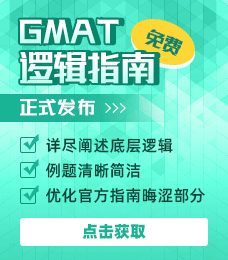The most salient changes involve a rehashing of the explanations (NOTE: the following changes apply to all three books). On the quantitative side, problem solving questions are illustrated with more step-by-step solutions. While there seems to be little change as far as the approach taken (i.e. how to solve), the Guide now categorizes each problem by topic (e.g. properties of numbers, geometry area, etc), and the physical layout of each problem is much easier to read. In the data sufficiency section, the solutions are also more logically organized by statement. Statement (1) is addressed, deemed sufficient or insufficient and then statement (2) is dealt with similarly in a separate paragraph. This makes the process of solving data sufficiency much clearer.
On the verbal side, the explanations were overhauled to even greater extent. It seems that the authors have recognized the student's need to clearly understand why each wrong answer choice is wrong because the explanations are now organized by answer choice. This much welcomed change allows the student to practice the systematic elimination of wrong answer choices that is so vital to success on the verbal section of the GMAT.
Topic categories are also assigned to each question in all three verbal question types. To this end, reading comprehension questions are officially divided into six types: main idea, supporting ideas, inference, application (of information), logical structure and style/tone. Likewise critical reasoning questions are separated into one of three categories: argument construction, argument evaluation and evaluation of a plan. Perhaps even more noteworthy, are the situation and reasoning sections included in each critical reasoning explanation. The situation section recaps the argument in fewer words and the reasoning section highlights the logic involved in solving the question. Lastly, in sentence correction, there are eight grammatical issues by which the questions are identified (many are tagged with more than one issue). The explanation begins with an overview of all of the errors that occur, not only in answer choice A, but also in the other four answer choices. Then the answer choices are listed one-by-one with their respective errors. The new format offers greater readability and utility.
How many of the questions in the 3 new Official Guides are the same as those in their predecessor, The Official Guide to GMAT Review, 10th edition? On the math side, the 10th edition included 441 problem solving and 274 data sufficiency. Of those, 328 of the problem solving and 215 of the data sufficiency show up in either the 11th edition or the Quantitative Review. In addition, the 11th edition offers 121 unique problem solving and 82 unique data sufficiency questions. This amounts to a net gain of 8 problem solving and 23 data sufficiency in the new editions. It is worth noting that The Official Guide for GMAT Quantitative Review contains no new questions; it is completely redundant to the 10th edition. All of the unique questions in the new guides appear in The Official Guide For GMAT Review, 11th edition. On the verbal side, 201 of the 10th edition's 268 sentence correction questions appear in the new guides, along with 67 new questions in the 11th edition. In critical reasoning, 160 of the 205 questions in the 10th edition appear in the new guides, along with 63 new questions in the 11th edition. This amounts to a net gain of 18 critical reasoning questions. Lastly in reading comprehension, 33 of the 48 passages from the 10th edition are represented in the new guides, along with 11 new passages. This represents a net loss of 4 passages in the new guides.
In terms of the difficulty level of the new questions the 11th edition, it seems that the 11th editions are comparable to the 10th. While a few of the hardest questions from the 10th edition have disappeared, they seem to have been replaced by a fair number of difficult questions at the end of the 11th edition's data sufficiency and problem solving sections, as well as in the new 100-question diagnostic section at the beginning of the book. A significant added benefit to the 11th edition and the two supplemental books is the GMAC's claim that the questions in each section are arranged by increasing level of difficulty. The cautious student should keep in mind, however, that this is only an assertion made by GMAC. As a final note on the new materials available from GMAC to prepare for the GMAT in 2006, the GMAC has made available new software to emulate the test-taking experience. The software includes five 15-question practice sections and 2 adaptive practice exams. There appears to be no overlap between the questions for the two exams and the questions contained in three new Official Guides. The software also matches the format of the new exam, administered by Pearson Vue testing centers, in terms of font, color scheme, and screen layout. The GMATPrepTM software is available for free download at www.mba.com.






 匿名
发表于 1970-1-1 08:00:00
匿名
发表于 1970-1-1 08:00:00










 京公网安备11010202008513号
京公网安备11010202008513号